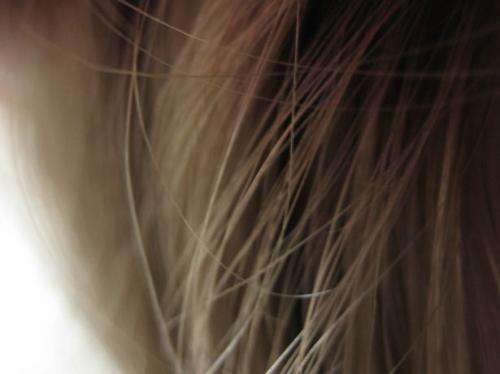February 7, 2018 report
Wheat gluten found to restore bonds in brittle human hair

A team of researchers from Jiangnan University in China and the University of Nebraska in the U.S. has found that integrating wheat gluten into a shampoo helps restore bonds, making hair less brittle. In their paper published in the journal Royal Society Open Science, the team describes their experiments with wheat gluten and hair and what they found.
Human hair is made mostly of keratin, a fibrous protein. In its natural state, hair is generally soft due to secure and unbroken bonds known as disulfide bridges. But shampoos meant to clean away oil and dirt also harm the bonds that hold the keratin together. The result is brittle hair that quite often develops split ends.
Scientists have known for some time that treatment of brittle hair requires the application of a protein to replace the broken bonds, but have been stymied by a simple problem—for such proteins to bond, they must have the same pH value as the hair. And a matching protein has proved elusive. To overcome this problem, the researchers turned to wheat gluten because it is inexpensive and plentiful. It does not have the right pH value, but the team wondered whether changing its pH might help it repair hair. After some trial and error, they came up with a procedure that worked—they soaked the gluten in an enzyme that broke down its proteins into their base peptides. They added EDDAC, a chemical formula that raised the isoelectric point of the peptides to match that in hair. They then mixed the result into a shampoo and applied to it hair samples.
The team tested their approach by running a comb through the treated hair samples using measurements of friction as a gauge for the degree of hair damage. They report that application of their gluten-infused shampoo resulted in 21 percent less friction in dry hair and 50 percent less in wet hair. They also looked at the hair samples under a microscope and report that they were able to see newly formed bonds—the hair was smoother and less brittle. More testing is required, but the researchers are confident that they have at long last found a cure for split ends.
More information: Modification of wheat gluten for improvement of binding capacity with keratin in hair, Royal Society Open Science (2018). Published 7 February 2018.DOI: 10.1098/rsos.171216 , rsos.royalsocietypublishing.org/content/5/2/171216
Abstract
In this study, enzymatic hydrolysis and cationization with epoxypropyldodecyldimethylammonium chloride of wheat protein, an economic protein complex containing great amount of disulfide bonds, were conducted to improve properties such as solubility and disassociation behaviour for recovery of damaged hair when used in shampoo. The optimal conditions for enzymatic hydrolysis were pH 8.2, 55°C with Alcalase for 60 min. After the selected hydrolysis, the degree of hydrolysis, nitrogen solubility index, foaming capacity index, foam stability index, emulsifying activity index and emulsion stability index of hydrolysate with 58.71% of short-chain peptides (less than 1000 Da) were 8.81%, 39.07%, 225%, 56.67%, 9.62 m2 g−1 and 49.08, respectively. The cationization was followed to raise the isoelectric point of wheat protein hydrolysate from 7.0 to 10.0, which could facilitate the quaternized protein hydrolysate to adhere to the surface of hair at the range of pH 5–6 of hair care products to form more disulfide bonds. The results show that a shampoo with quaternized wheat proteins hydrolysate possesses excellent properties in recovering damaged hair, making the surface of hair smooth and compact.
Journal information: Royal Society Open Science
© 2018 Phys.org

















